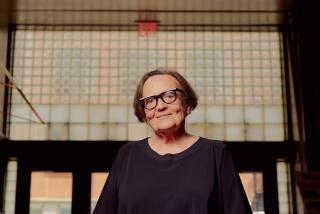Review: The documentary âStill Life in Lodzâ reveals the power of mementos and memories
If a picture is worth a thousand words, itâs also worth a documentary inspired by one. That would be director Slawomir GrĂźnbergâs moving and evocative âStill Life in Lodz,â which centers around a painting that hung in the same tenement apartment in Lodz, Poland, for 75 years. It also became a kind of touchstone for young Lilka Elbaum, who beheld the staid portrait of fruit, flowers, wine and more, every day for her first 19 years, from 1949 to 1968. That was when she and her family lived in said apartment, a roomy, then-desirable place that overlooked a busy thoroughfare in front and a quieter courtyard in back.
In the film, Elbaum, the daughter of Holocaust survivors, returns to Lodz (pronounced âWoodgeâ), once Polandâs second most populous Jewish city, to revisit the Kilinskiego Street apartment in which she grew up and to track down the painting sheâd never forgotten. But her trip evolves into a deeper look back at Lodzâs fraught history, including how the Nazi invasion of 1939 decimated the cityâs Jewish citizenry and how the anti-Semitism that prevailed in the decades after World War II shaped Lodz â and Elbaumâs life. (She and her family were forced to leave Poland â and the painting â in 1968, during which time the government had dubbed Jews âthe enemy of the stateâ; the Elbaums settled in Canada, with Lilka later moving to the U.S.)
But Elbaum, who narrates and co-wrote with GrĂźnberg, isnât the only one in the film with familial ghosts to explore in Lodz. She invites two compatriots to join her in front of the cameras: New Yorker Paul Celler, whose mother miraculously survived her wartime deportation to the Lodz Ghetto and, later, the Auschwitz concentration camp; and Israeli artist Roni Ben Ari, whose familyâs thriving textile shop was once located on the ground floor of Elbaumâs childhood apartment building.
Together and separately, the three return to various sites in and around Lodz where they relive and unravel a mix of difficult and illuminating stories of Holocaust-era life through the lingering memories of their ancestors.
Elbaum spends significant time in her family apartment, now just one of many empty, faded units in the neglected, 1893-built complex. Its former grandeur can still be imagined and it sparks a wealth of recollections. She also recounts her search for the still life paintingâs original owner, a groundbreaking Jewish woman dentist who perished in the Holocaust, as well as her tracking down of the portraitâs current owner in suburban Lodz.
In another vivid sequence, Elbaum visits a farm in the Polish countryside where in 1942 her mother, about to be sent to the Treblinka death camp, was fortuitously taken in by a sympathetic Gentile family, the Chorazkiewiczes, and hidden from the Nazis for 2 1/2 years. Itâs a remarkable story made even more so by Elbaumâs warm reunion with the Chorazkiewiczesâ extended family both at the farm and back in Lodz.
Celler has some especially powerful moments when he goes to historic Radegast Station, which was the arrival point for Jews deported to the Lodz Ghetto and the departure site for those being taken to the extermination camps. When Celler steps onto one of the stationâs preserved cattle cars, the kind his mother must have boarded for Auschwitz, itâs chilling and intense.
More joyfully, Celler, a self-taught musical virtuoso, gets a rare chance to play the piano inside the opulent palace of the late Jewish textile magnate and philanthropist, Izrael Poznanski.
Ben Ari, whose roots in Lodz precede those of Elbaum and Celler (her family left Poland for Romania in 1926 before settling in Israel), enjoys a transporting tour of the third-floor Kilinskiego Street apartment where her father and grandfather once lived. She also touchingly places the menorah sheâd inherited from her grandfather on the apartment windowsill where it once sat, reminding us, as the film often does, of the eternal value of mementos â and memories â passed down through the generations.
GrĂźnberg effectively incorporates archival photos and footage, drawings, and lyrical, illustrative bits of animation into this brief but rich documentary, which ends on a lovely note that brings Elbaumâs journey full circle.
'Still Life in Lodz'
In Polish and English with English subtitles.
Not rated
Running time: 1 hour, 16 minutes
Playing: Starts March 12, Laemmle Virtual Cinema
More to Read
Only good movies
Get the Indie Focus newsletter, Mark Olsen's weekly guide to the world of cinema.
You may occasionally receive promotional content from the Los Angeles Times.










